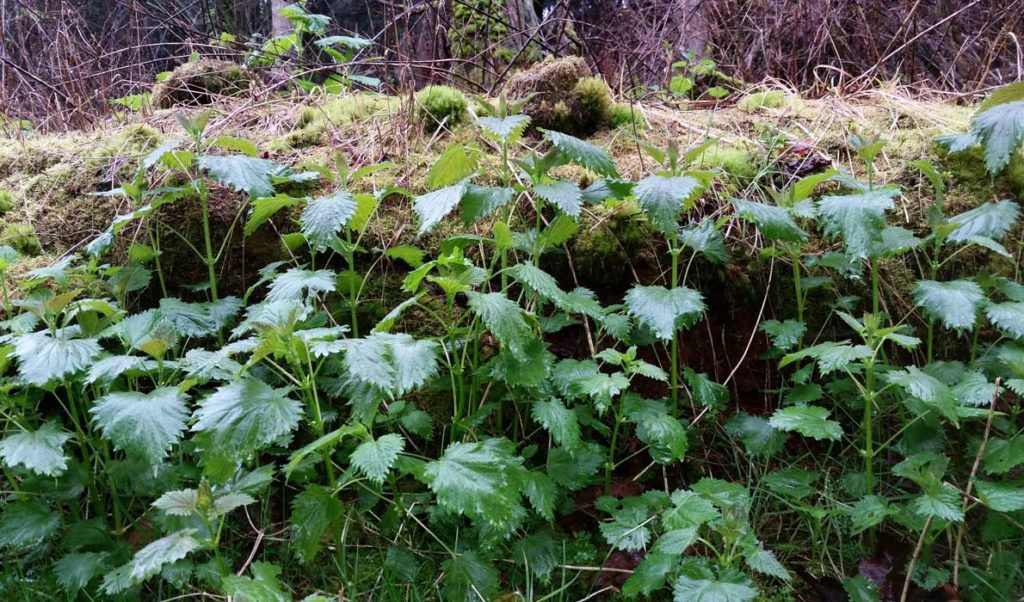Islanders are lucky because they have a weed habitat—saltwater shoreline—that inlanders don’t, but no matter, we all have plentiful weedy places on which to graze. Like mainly our gardens. Well, maybe you don’t have a weedy garden but, Lord help me, I do.
As luck would have it, the most plentiful weeds turn out to be the most useful in the kitchen, and I’m not even talking about dandelions which you have to eat early on before they blossom; these others obligingly sprout fresh all summer long. Charming.
First and favorite is lamb’s quarters. The nutrition information on this one is lots of calcium, protein and vitamins A, C, and K. Like a fair number of our weeds, especially those we find in gardens or farmland, this one was a cultivated plant in the Old World, and brought here to New England by settlers.
I go out and pick the tender green tops before they bloom, eat them raw in salad, or, preferably, mix them roughly half and half with kale or spinach, blanch or steam them just enough to wilt them, then chop them coarsely and stir fry them with lots of onions, shallots and garlic. So good.
Then there is wood sorrel. I remember chewing on these clover-like leaves when I was a little kid—I liked their sourness and it was a little thrilling eating something that grew wild.
Turns out that wood sorrel mixed with domestic sorrel makes a spectacularly snappy sorrel soup, perfect for hot weather eating. You could probably make the soup with only wild sorrel, but I grow both. I pick the leaves off the sorrels, and add them to sautéed and softened aromatics like onions, celery, garlic and carrots. Then I can add vegetable or chicken broth, and cook them a little while before pureeing them. Salt and pepper to taste, and sample it to see if it is snappy enough. If not, go back outside for another hit of weed, so to speak. You can add cream or sour cream to the soup when you serve it, or thicken it with a little mashed potato.
Chickweed is one of the tastiest wild edibles I’ve encountered. Where so many weeds mostly taste “green,” chickweed’s distinctive character is perfect for use raw in salad. Chickweed plants itself thickly, and of all the weeds, these are most tedious to pick because they are so small. If you can either thin it somewhat or find the plants that are not crowded, you’ll find lovely large leaves as big as a fingernail, best gathered before the plant blooms. Or pick the end cluster of small ones. When they come straight from the garden, I don’t bother to wash them, which saves a real pain in the neck.
Then there is purslane, whose main virtue is its abundance. Whole sections of my garden are absolutely paved in purslane. I still haven’t quite achieved the tastiest way of preparing it. It is edible raw in salad, and it is supposed to be good pickled. The succulent leaves apparently contain a high dose of omega three fatty acids and they are cheaper than walnuts.
I have noticed that they are susceptible to leaf miners and unless you want a little extra protein, you might want to compost the infested purslane and go for the one with no bugs. There is a gorgeous domestic purslane, Golden Purslane, which you can acquire and which produces large, chartreuse leaves. It is fun to mix the wild and domestic in a salad.
Along the shore in the intertidal zone, you can find sea pickle, a light gray green succulent that has a crunchy, salty quality perfect for raw eating in salad. Old timers told me about it long ago, apparently gathered and literally pickled in vinegar for extended use after it bloomed. I love the stuff, partly because I get to wander around on a beach for a while to acquire it, and also because I love salt.
My experience with weeds and other wild stuff, like spruce tips which make a spectacular sorbet, have impressed me with their cheerful volunteerism. They show up in great numbers, work hard and don’t ask for anything in return except to be left alone. Unlike the spoiled brats of the vegetable world, tomatoes, which require coddling, and fawning attention all summer long, and deign at last to produce the precious fruits that we all clamor for before they collapse at the first breath of cold, my garden weeds plant themselves, sort out their place in the garden by natural competition, attract and supply food for pollinators, and act as a ground cover and living mulch.
God bless the weeds.
Sandy Oliver is a food historian who lives, writes and cooks on Islesboro.





